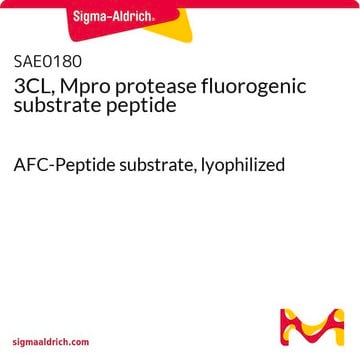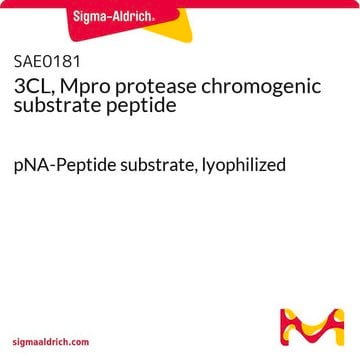SML2973
MCA-AVLQSGFR-Lys(Dnp)-Lys-NH2 trifluoroacetate
≥95% (HPLC)
Synonym(s):
N-[2-(7-methoxy-2-oxo-2H-1-benzopyran-4-yl)acetyl]-L-alanyl-L-valyl-L-leucyl-L-glutaminyl-L-serylglycyl-L-phenylalanyl-L-arginyl-N6-(2,4-dinitrophenyl)-L-lysyl-L-Lysinamide trifluoroacetate
Sign Into View Organizational & Contract Pricing
All Photos(1)
About This Item
Empirical Formula (Hill Notation):
C69H99N19O20 · xC2HF3O2
CAS Number:
Molecular Weight:
1514.64 (free base basis)
UNSPSC Code:
12352200
NACRES:
NA.77
Recommended Products
Biochem/physiol Actions
MCA-AVLQSGFR-Lys(Dnp)-Lys-NH2 is a fluorescence resonance energy transfer (FRET) substrate derived from the N-terminal auto-cleavage fragment of the SARS-CoV Mpro viral protease ((excitation wavelengths 320 nm and emission wavelengths 405 nm). MCA-AVLQSGFR-Lys(Dnp)-Lys-NH2 is suitable to measure protease activity of COVID-19 virus Mpro, SARS-CoV Mpro, and other viruses.
Storage Class Code
11 - Combustible Solids
WGK
WGK 3
Flash Point(F)
Not applicable
Flash Point(C)
Not applicable
Certificates of Analysis (COA)
Search for Certificates of Analysis (COA) by entering the products Lot/Batch Number. Lot and Batch Numbers can be found on a product’s label following the words ‘Lot’ or ‘Batch’.
Already Own This Product?
Find documentation for the products that you have recently purchased in the Document Library.
Xiaoyu Xue et al.
Journal of molecular biology, 366(3), 965-975 (2006-12-27)
The viral proteases have proven to be the most selective and useful for removing the fusion tags in fusion protein expression systems. As a key enzyme in the viral life-cycle, the main protease (M(pro)) is most attractive for drug design
Zhenming Jin et al.
Nature, 582(7811), 289-293 (2020-04-10)
A new coronavirus, known as severe acute respiratory syndrome coronavirus 2 (SARS-CoV-2), is the aetiological agent responsible for the 2019-2020 viral pneumonia outbreak of coronavirus disease 2019 (COVID-19)1-4. Currently, there are no targeted therapeutic agents for the treatment of this disease, and
Fenghua Wang et al.
Scientific reports, 6, 22677-22677 (2016-03-08)
First identified in The Netherlands in 2004, human coronavirus NL63 (HCoV-NL63) was found to cause worldwide infections. Patients infected by HCoV-NL63 are typically young children with upper and lower respiratory tract infection, presenting with symptoms including croup, bronchiolitis, and pneumonia.
Our team of scientists has experience in all areas of research including Life Science, Material Science, Chemical Synthesis, Chromatography, Analytical and many others.
Contact Technical Service








